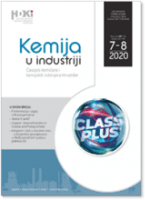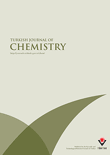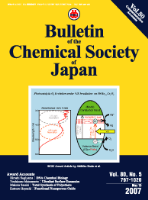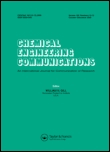
Kemija u Industriji-Journal of Chemists and Chemical Engineers
Scope & Guideline
Exploring the frontiers of chemistry and industry.
Introduction
Aims and Scopes
- Chemical Analysis and Characterization:
The journal publishes studies involving chemical analysis methods, including spectroscopy, chromatography, and electrochemical techniques, to characterize materials and chemical substances. - Environmental Chemistry and Sustainability:
Research focused on environmental impacts, waste management, and sustainable practices in chemical engineering is a core area, addressing issues like pollution control and resource recovery. - Innovative Chemical Processes:
The journal highlights advancements in chemical processes, including the development of new materials, reaction mechanisms, and optimization of existing processes for improved efficiency. - Biochemical and Biotechnological Applications:
There is a significant emphasis on biocatalysis, bio-remediation, and the use of biochemical methods in chemical engineering, reflecting the interdisciplinary nature of modern chemistry. - Material Science and Engineering:
Research on the synthesis, characterization, and application of new materials, including polymers, nanomaterials, and composites, is frequently featured, showcasing innovations in material science. - Machine Learning and Computational Methods:
The integration of machine learning and artificial intelligence in chemical research and process optimization is gaining traction, indicating a shift towards data-driven methodologies in the field.
Trending and Emerging
- Green Chemistry and Sustainability:
There is an increasing focus on green chemistry practices, including eco-friendly synthesis methods and sustainable resource management, highlighting the industry's commitment to environmental stewardship. - Advanced Wastewater Treatment Technologies:
Research on innovative wastewater treatment solutions, particularly using biowaste and novel materials, is gaining prominence, reflecting the urgent need for effective environmental remediation. - Integration of Artificial Intelligence in Chemistry:
The application of machine learning and AI in chemical research and process optimization is rapidly emerging, showcasing a trend towards data-driven decision-making in chemical engineering. - Bio-based Materials and Biopolymers:
The development and application of bio-based materials, including biopolymers and biodegradable composites, are trending, indicating a shift towards sustainable material science. - Circular Economy Practices:
Research on circular economy principles, particularly in relation to waste management and resource recovery, is becoming increasingly relevant within the journal's scope. - Impact of COVID-19 on Chemical Practices:
Studies examining the effects of the COVID-19 pandemic on chemical engineering practices and public health-related research are emerging, reflecting a timely response to global challenges.
Declining or Waning
- Traditional Chemical Engineering Topics:
There appears to be a waning interest in more established areas of chemical engineering, such as classical thermodynamics and unit operations, as the field evolves to include more innovative and interdisciplinary approaches. - Inorganic Chemistry Applications:
Research specifically focused on inorganic compounds and their applications seems to be less prominent, possibly overshadowed by the rise of organic and biochemistry topics. - Historical Perspectives:
Papers that provide historical context or retrospective analyses of chemical engineering practices are becoming less frequent, indicating a shift towards forward-looking and practical research. - Conventional Waste Treatment Methods:
Studies focusing solely on conventional methods of waste treatment are declining, as newer, more sustainable technologies and practices are being prioritized. - Local Industry Case Studies:
There has been a noticeable reduction in the publication of case studies centered around local industrial practices, possibly due to a broader focus on global challenges and solutions.
Similar Journals

Orbital-The Electronic Journal of Chemistry
Fostering Interdisciplinary Dialogue in ChemistryOrbital - The Electronic Journal of Chemistry, ISSN 1984-6428, is an esteemed open-access journal published by the Universidade Federal de Mato Grosso do Sul, Department of Chemistry, since 2009. Located in the vibrant academic landscape of Campo Grande, Brazil, this journal aims to bridge the gap between research and practice in the fields of Chemistry, Chemical Engineering, and Materials Science. Despite its current categorization in the Q4 quartile ranks, Orbital plays a pivotal role by providing a platform for innovative ideas, emerging technologies, and interdisciplinary research that advances the understanding of chemical processes and materials. With its commitment to open access, the journal ensures that research findings are readily available to a global audience, promoting collaboration and knowledge dissemination among researchers, professionals, and students alike. Readers can expect a diverse range of articles, from foundational chemistry studies to cutting-edge developments in materials science, reflecting the journal’s dynamic scope and contribution to the scientific community.

TURKISH JOURNAL OF CHEMISTRY
Innovative Insights for a Dynamic DisciplineTURKISH JOURNAL OF CHEMISTRY, published by the Tubitak Scientific & Technological Research Council Turkey, serves as a significant platform for the dissemination of research in the diverse field of chemistry. Since its inception in 1996, this peer-reviewed journal has made substantial contributions to the body of knowledge within the field, currently holding a respectable Q3 ranking in the category of Chemistry (miscellaneous) as of 2023. Researchers and professionals alike rely on this journal for its wide-ranging discussions, innovative methodologies, and noteworthy findings pertinent to both fundamental and applied chemistry. With an ISSN of 1300-0527 and a commitment to promoting scientific progress, the journal is accessible to a global audience and encourages the open sharing of insights that drive advancements in chemistry. The extended timeframe of convergence until 2024 highlights the journal's dedication to fostering ongoing research and collaboration within the scientific community. As a valuable resource for researchers, professionals, and students, the Turkish Journal of Chemistry aims to inspire new discoveries and facilitate knowledge transfer in a dynamic and evolving discipline.

BULLETIN OF THE CHEMICAL SOCIETY OF JAPAN
Showcasing Excellence: A Nexus for Chemical ScholarshipBULLETIN OF THE CHEMICAL SOCIETY OF JAPAN, published by the esteemed Chemical Society of Japan, serves as a pivotal platform for the dissemination of cutting-edge research in the multifaceted field of chemistry. With an ISSN of 0009-2673 and an E-ISSN of 1348-0634, this journal has been integral in fostering the growth of chemical sciences globally since its inception in 1965. The journal holds an impressive Q2 ranking in the Chemistry (miscellaneous) category, indicating its relevance and influence within the academic community, as reflected by its Scopus rank of #104/408, placing it in the 74th percentile. Although it is not an open-access journal, its rich content, which spans a wide range of topics in general chemistry, remains highly valued by researchers, professionals, and students alike, affirming its crucial role in advancing both theoretical knowledge and practical applications in chemistry. As it converges towards 2024, the bulletin continues to uphold its commitment to excellence in scientific communication and research dissemination in Japan and beyond.

Solid Fuel Chemistry
Transforming Knowledge into Energy InnovationsSolid Fuel Chemistry is a pivotal journal published by PLEIADES PUBLISHING INC, dedicated to advancing knowledge in the fields of chemical engineering, chemistry, and fuel technology. With its ISSN 0361-5219 and E-ISSN 1934-8029, this esteemed publication has been contributing to the scientific community since its inception, covering extensive research from 1975 to 2024. Operating within the Q3 and Q4 quartiles, it holds a significant position among peers in its categories, ranked 94th in Energy & Fuel Technology and 212th in General Chemical Engineering. Although it lacks an open access option, the journal remains a vital resource for researchers, professionals, and students eager to explore innovative developments in solid fuels and their applications. The articles published in Solid Fuel Chemistry provide essential insights, facilitate collaboration, and inspire further research, making it an indispensable platform for anyone engaged in this essential field of study.

Applied Chemistry for Engineering
Innovating Solutions Through Applied ChemistryApplied Chemistry for Engineering, published by the Korean Society of Industrial and Engineering Chemistry, is a vital resource for researchers and professionals engaged in the realms of chemical engineering and applied chemistry. With an ISSN of 1225-0112 and an E-ISSN of 1228-4505, this journal serves as a platform for innovative research that spans diverse applications within these fields. Although currently not classified under open access, it provides critical insights and advancements to its audience, contributing to the ongoing discourse in the industry. The journal's significance is underscored by its rankings in Scopus, where it resides in the Q4 category for both Chemical Engineering and Chemistry, evidencing its commitment to publishing relevant studies despite its emerging status. As it continues to grow through the converged years from 2007 to 2024, Applied Chemistry for Engineering aims to bridge the gap between theoretical research and practical engineering solutions, making it an essential tool for students, researchers, and professionals alike.

University Politehnica of Bucharest Scientific Bulletin Series B-Chemistry and Materials Science
Pioneering Research for Tomorrow's ChallengesUniversity Politehnica of Bucharest Scientific Bulletin Series B-Chemistry and Materials Science is a renowned academic journal published by POLYTECHNIC UNIV BUCHAREST, situated in Romania. With the ISSN 1454-2331, this journal serves as a dynamic platform for the dissemination of innovative research findings in the fields of chemistry and materials science. Although classified in the Q4 quartile of both Chemistry (miscellaneous) and Materials Science (miscellaneous) categories for 2023, it has made a significant impact by providing a venue for emerging scholars and established researchers alike to share their work. The journal seeks to bridge theoretical insights and practical applications, promoting interdisciplinary dialogue and advancing scientific understanding. The scope encompasses a broad range of topics, reflecting contemporary advancements and challenges within the field. To facilitate access to its articles, while it does not currently operate under an open-access model, the journal remains committed to enhancing visibility through digital libraries. With a publication history spanning from 1999 to 2024, the journal is vital for all stakeholders—researchers, professionals, and students—seeking to stay abreast of developments in chemistry and materials science.

CHEMICAL ENGINEERING COMMUNICATIONS
Pioneering Research for a Sustainable Future.Chemical Engineering Communications, published by Taylor & Francis Inc, is a distinguished journal within the realms of Chemical Engineering and Chemistry. With an ISSN of 0098-6445, this journal plays a pivotal role in disseminating innovative research, critical reviews, and insightful discussions that encompass a broad spectrum of topics in these fields. The journal boasts a commendable Q2 ranking in the 2023 category of chemical engineering and general chemistry, reflecting its significant contribution to the scientific community. Operating under a rigorous peer-review process, the journal attracts high-quality submissions from global researchers. Although currently not an Open Access journal, it provides extensive archive access for users interested in exploring past advancements from its inception in 1973 through to 2024. With a commitment to advancing knowledge and fostering collaboration among academia and industry, Chemical Engineering Communications remains an essential resource for professionals and students aiming to stay abreast of the latest developments in chemical sciences.

INDIAN JOURNAL OF CHEMICAL TECHNOLOGY
Fostering Global Dialogue in Chemical EngineeringThe Indian Journal of Chemical Technology, published by the Natl Inst Science Communication-NISCAIR, is a pivotal platform for the dissemination of innovative research in the field of chemical technology. With an ISSN of 0971-457X and an E-ISSN of 0975-0991, this journal has been serving the academic community since its inception in 1994, and is set to continue through 2024. The journal holds a Q4 ranking in both the Chemical Engineering and Chemistry categories as of 2023, though it showcases a significant breadth of research, making it a valuable resource for both emerging and established scholars. Although it currently operates without an open-access model, the journal aims to facilitate knowledge exchange through rigorous peer-reviewed publications, allowing researchers and professionals to stay updated with the latest advancements and practices in chemical technology. Located in New Delhi, India, the journal not only contributes to national scientific dialogue but also plays a key role in the global conversation around chemical sciences by addressing unique challenges and innovations pertinent to the region.

SOUTH AFRICAN JOURNAL OF CHEMISTRY-SUID-AFRIKAANSE TYDSKRIF VIR CHEMIE
Elevating South African Chemistry on the Global StageSouth African Journal of Chemistry (Suid-Afrikaanse Tydskrif vir Chemie), published by Bureau Scientific Publications, is a pivotal open-access journal that has been disseminating groundbreaking research in the field of chemistry since its inception in 1996. With an ISSN of 0379-4350 and an E-ISSN of 1996-840X, this journal serves as a vital platform for researchers and professionals seeking to share their work and engage with the global chemistry community. Recognized for its significant contributions, the journal holds a Q3 quartile ranking in the miscellaneous chemistry category as of 2023 and ranks #216 out of 408 in General Chemistry according to Scopus. The South African Journal of Chemistry is dedicated to advancing knowledge in the discipline by publishing a wide array of articles, reviews, and studies that address pertinent chemical research and applications. With open access options available since 2000, it fosters a collaborative environment, ensuring that research is accessible to all, thereby enhancing the visibility and impact of chemists' work across South Africa and beyond.

Journal of Chemistry and Technologies
Exploring Technologies for Tomorrow's Solutions.The Journal of Chemistry and Technologies, published by OLES HONCHAR DNIPROPETROVSK NATIONAL UNIVERSITY, is an open access journal dedicated to advancing knowledge in the broad fields of chemistry and chemical engineering since its inception in 2013. With ISSN 2663-2934 and E-ISSN 2663-2942, this journal provides a vital platform for researchers and professionals, particularly in Ukraine and beyond, to share innovative research findings and contemporary technological advancements. Currently ranked in the Q4 quartile in both Chemical Engineering and General Chemistry for 2023, it serves as an enriching resource for those interested in emerging trends and interdisciplinary studies within these domains. The journal adheres to high academic standards while fostering collaboration in the scientific community by offering open access articles that ensure visibility and accessibility to a global audience. As an important part of the academic landscape, the Journal of Chemistry and Technologies aims to inspire future research and development, paving the way for new discoveries and applications in chemistry-related fields.